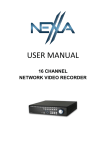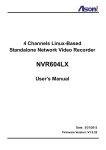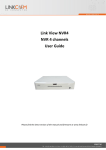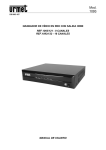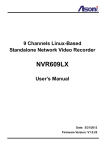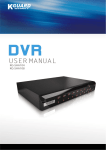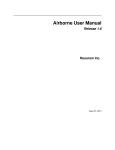Download HDR-04FE_User Manual_ENG
Transcript
Link View HNVR9 Hybrid NVR 9 channels User Guide Please find the latest version of the manual and firmware at www.linkcom.fr 0 INSTRUCTION MANUAL To obtain the best performance and ensure device function correctly, please read this instruction manual carefully and completely. FCC Compliance USER-INSTALLER CAUTION: YOUR AUTHORITY TO OPERATE THIS FCC VERIFIED EQUIPMENT COULD BE VOIDED IF YOU MAKE CHANGES OR MODIFICATIONS NOT EXPRESSLY APPROVED BY THE PARTY RESPONSIBLE FOR COMPLIANCE TO PART 15 OF THE FCC RULES. NOTE: THIS EQUIPMENT HAS BEEN TESTED AND FOUND TO COMPLY WITH THE LIMITS FOR A CLASS A DIGITAL DEVICE, PURSUANT TO PART 15 OF THE FCC RULES. THESE LIMITS ARE DESIGNED TO PROVIDE REASONABLE PROTECTION AGAINST HARMFUL INTERFERENCE WHEN THE EQUIPMENT IS OPERATED IN A COMMERCIAL ENVIRONMENT. THIS EQUIPMENT GENERATES, USES, AND CAN RADIATE RADIO FREQUENCY ENERGY AND IF NOT INSTALLED AND USED IN ACCORDANCE WITH THE INSTRUCTION MANUAL, MAY CAUSE HARMFUL INTERFERENCE TO RADIO COMMUNICATIONS. OPERATION OF THIS EQUIPMENT IN A RESIDENTIAL AREA IS LIKELY TO CAUSE HARMFUL INTERFERENCE IN WHICH CASE THE USER WILL BE REQUIRED TO CORRECT THE INTERFERENCE AT HIS OWN EXPENSE. THIS CLASS A DIGITAL APPARATUS MEETS ALL REQUIREMENTS OF THE CANADIAN INTERFERENCE-CAUSING EQUIPMENT REGULATIONS. WARNINGS, CAUTIONS & COPYRIGHT WARINGS TO REDUCE THE RISK OF FIRE OR ELECTRIC SHOCK, DO NOT EXPOSE THIS PRODUCT TO RAIN OR MISTURE. DO NOT INSERT ANY METALLIC OBJECT THROUGH VENTILATION GRILLS. CAUTION CAUTION RISK OF ELECTRIC SHOCK DO NOT OPEN CAUTION: TO REDUCE THE RISK OF ELECTRIC SHOCK. DO NOT REMOVE COVER (OR BACK). NO USER-SERVICEABLE PARTS INSIDE. REFER SERVICING TO QUALIFIED SERVICE PERSONNEL. Explanation of Graphical Symbols The lightning flash with arrowhead symbol, within an equilateral triangle, is intended to alert the user to the presence of insinuated "dangerous voltage" within the products enclosure that may be of sufficient magnitude to constitute a risk of electric shock to persons. The exclamation point within an equilateral rhombus is intended to alert the user to the presence of important operating and maintenance (servicing) instruction in the literature accompanying the product. USERS OF THE SYSTEM ARE RESPONSIBLE FOR CHECKING AND COMPLYING WITH ALL FEDERAL, STATE, AND LOCAL LAWS AND STATUTES COIPCERNING THE MONITORING AND RECORDING OF VIDEO AND AUDIO SIGNALS. LINKCOM SHALL NOT BE HELD RESPONSIBLE FOR THE USE OF THIS SYSTEM IN VIOLATION OF CURRENT LAWS AND STATUTES. COPYRIGHT THE TRADEMARKS MENTIONED IN THE MANUAL ARE LEGALLY REGISTERED TO THEIR RESPECTIVE COMPANIES. 1 TABLE OF CONTENTS 1 2 3 4 5 INTRODUCTION...................................................................................................................... 3 1.1 FEATURE.......................................................................................................................3 1.2 SPECIFICATION..........................................................................................................3 HARDWARE OVERVIEW...................................................................................................... 6 2.1 FRONT PANEL .............................................................................................................6 2.2 CAMERA & MONITOR LOOPING...........................................................................8 2.3 ALARM TRIGGER.......................................................................................................8 2.4 PTZ (PAN, TILT AND ZOOM) CAMERA ...............................................................10 SYSTEM SETUP ..................................................................................................................... 11 3.1 MENU SETUP INTERFACE(GUI)........................................................................... 11 3.2 LIVE VIEWING AND POP-UP MENU....................................................................13 3.3 CAMERA SETUP ........................................................................................................17 3.4 RECORD SETUP ........................................................................................................27 3.5 ALARM SETUP...........................................................................................................28 3.6 NETWORK SETUP ....................................................................................................30 3.7 AUTHORITY SETUP .................................................................................................35 3.8 DISK MANAGEMENT...............................................................................................37 3.9 SYSTEM SETUP .........................................................................................................39 HYBRID DVR PLAYBACK................................................................................................... 44 4.1 TIME SEARCH ...........................................................................................................45 4.2 EVENT SEARCH ........................................................................................................45 4.3 BACKUP.......................................................................................................................46 4.4 SYSTEM LOG .............................................................................................................47 BACKUP PLAYBACK ........................................................................................................... 48 5.1 MAIN SCREEN SETTING.........................................................................................48 5.2 PLAYBACK OPERATION ........................................................................................51 6 NETWORK VIEWING & PLAYBACK ............................................................................... 54 6.1 IP ADDRESS SETUP ON PC SITE...........................................................................54 6.2 OPTIONAL MICROSOFT INTERNET EXPLORER SETUP..............................56 6.3 LOGIN ..........................................................................................................................58 6.4 REMOTE CONTROL.................................................................................................59 6.5 CONFIGURE ...............................................................................................................64 APPENDIX A: RECORDING TIME LAPSE (HOURS)............................................................. 79 APPENDIX B: HDD COMPATIBLE TABLE .............................................................................. 80 APPENDIX C: ERROR MESSAGE LIST.................................................................................... 82 2 1 INTRODUCTION 1.1 FEATURE Support H.264 / MPEG4 / MJPEG decoding & H.264 encoding. Support up to 9-channel IP cameras input. Support up to 8-channel analog cameras input. Analog camera recording rate up to 120 PPS @ D1. Real-time Display & Playback. Support 5 Megapixel IP Camera for each channel. Audio:4 in & 1out. 1.2 Support HDDs x4. HDD damaged block detection & temperature alarm system (HDD S.M.A.R.T). Support Pre-alarm recording. Support Privacy Mask. Support e-SATA interface. Support HDMI Video interface . Graphic User Interface ( GUI ). Support time-point backup function under Ethernet remote control mode. User can select any time period to process backup from remote side. Support time-search & event-search function under Ethernet remote control mode. Up to four online clients for independent remote control; individual live-time, play-back & time-search function available Support PPPoE/ Static/ DHCP IP & DDNS. Powerful mobile surveillance function, support i-Phone & Android SPECIFICATION MODEL HBR-09EE System Embedded Linux OS Ethernet RJ-45, 10/100/1000 Mbps x1 connector VGA output HDMI output USB 2.0 Power D-SUB output HDMI output Front : 2 ports DC-12V, 5A Video and Audio 3 Video input (IP cam, Max) 9 channels Video input (Analog, Max) 8 channels Audio input 4 channels Audio output 1 channel Hybrid DVR Functions Camera Name Max. 20 characters Screen Split Control 1, 4, 9 Image Control Contrast / Brightness / Saturation / Hue Recording mode Manual / Schedule / Alarm Pre Recording 1~5 sec Watermark Support Searching and Playback Search Method Date / Time / Event Date/ Time / Event Search Selectable on the calendar Log Search Through the log data to find the video event / time Backup Type USB Remote Client Software Monitoring Environment Link View for iPhone / iPad /Android, Web site IP / Analog cam Live View 9 Channels Remote Search Web site remote time / event search System Monitoring and Recovery Monitoring Watchdog Alarm Alarm Input 8 inputs Alarm output 1 outputs Peripheral Devices Audio in 3.5 Ø Earphone stereo jack / RCA x4 Audio out 3.5 Ø Earphone stereo jack RS 485 2- pin terminal STORAGE & BACKUP DEVICE INTERNAL HDD SUPPORT SATA HDD x 4 EXTERNAL USB BACKUP DEVICE (PAN USB x2 4 DRIVE, HDD, BURNER) E-SATA x1 RAID N/A Networking Type Static/ DHCP/ PPPoE/DDNS Environment Operating Temp. 0 - 45 ℃ / 32~113 F Humidity 0~80% RH (non-condensing) Language Physical English / Traditional Chinese / Simple Chinese / Russian / Italian / Japanese / Czech / France / Germany / Spanish / Portuguese Dimensions (W x H x D) 360 x 60 x 311 mm Weight 4 KG Type * SPECIFICATIONS ARE SUBJECT TO CHANGE WITHOUT NOTICE 5 2 HARDWARE OVERVIEW 2.1 FRONT PANEL 10 6 5 7 8 11 12 1 2 3 4 22 Hybrid DVR OPERATION NO. LABEL OPERATION 1 Led Indicator LED USB Connector/ USB Mouse Connector 2 / 3 MIC IN Microphone input(Phone Jack) 4 AUDIO OUT Earphone output(Phone Jack) 20 21 9 13 14 16 15 17 18 19 6 BACK PANEL NO. LABEL OPERATION 1 E-SATA E-SATA interface 2 AUDIO OUT Audio Output 3 VIDEO OUT (VGA) Connect to LCD monitor 4 POWER Connect to power adapter (AC 12V/5A) 5 VIDEO OUT (HDMI) HDMI video output 6 ETHERNET RJ-45 connector 7 ALARM IN/ RELAY OUT/ RS-485 8 alarm in/ 1 relay out/ RS485 8 AUDIO IN Audio input 9 VIDEO IN BNC video input 10 FAN The fan louvers 7 2.2 CAMERA & MONITOR LOOPING Here recommend link cameras by sequence to avoid unexpected image broken, from CH1, CH2, CH3, CH4……. 2.3 ALARM TRIGGER There are three types of alarms: Motion detection, Video Loss Alarm, and External Alarm. Following are the possible action when alarm is triggered. Every action is configurable (Ex. the screen display pattern, the relay triggered time.etc) and will be explained in the later chapter. A. When Motion detection happens: a. The live screen pattern can be switch to single channel screen or split screen. b. External relay/ built-in buzzer can be triggered. c. Alarm timepoint can be recorded in the event list, and you can search for the event in playback. d. On the channel which the alarm triggered, the icon pops up to remind the user. e. The pre/ post-alarm recording video can be sent to e-mail/ uploaded to FTP. f. CGI can be sent to an http server. B. When External Alarm happens: a. External relay/ built-in buzzer can be triggered. b. Alarm timepoint can be recorded in the event list, and you can search for the event in playback. c. On the channel which the alarm triggered, the icon pops up to remind the user. d. The pre/ post-alarm recording video can be sent to e-mail/ uploaded to FTP. e. CGI can be sent to an http server. C. When Video Loss Alarm happens: a. External relay/ built-in buzzer can be triggered. b. Alarm timepoint can be recorded in the event list, and you can search for the event in playback. c. On the channel which the alarm triggered, the icon pops up to remind the user. CGI can be sent to an http server. 8 D. Alarm in connecter D+ RS-485: sends +/ receives + D- RS-485: sends -/ receives - GND Ground ALARM IN 1-8 Alarm input N.C Relay: Normally close N.O Relay: Normally open COM Relay: Common EX1:Connect GND & Alarm to external IR detector. EX2:Connect N.O & COM to external siren. Depending on the external device type, You may connect N.C & COM to external device. 9 2.4 PTZ (PAN, TILT AND ZOOM) CAMERA Following diagram for HYBRID DVR connect between PTZ camera & joystick controller, for HYBRID NVR to control PTZ camera please make sure the CAMERA ID, BANDRATE (default at 9600 bps) and RS-485 cable. 2 CORE Under “Two Core” connection, controller can control speed dome without integrated protocol into HYBRID DVR. Moreover, one keyboard can connect MAX 256 units of speed dome. 10 3 SYSTEM SETUP 3.1 MENU SETUP INTERFACE(GUI) A. CAMERA SETUP B. RECORD SETUP C. D. NETWORK SETUP ALARM SETUP 11 E. AUTHORITY SETUP G. SYSTEM SETUP F. DISK MANAGEMENT H. EXIT 12 3.2 LIVE VIEWING AND POP-UP MENU Tick the box to fix the function panel on right side. Untick it, then the function panel will be hidden when the mouse moves away. A. GUI MENU BAR With live viewing mode, press this button to get into the GUI menu. B. DISK INFORMATION With live viewing mode, press this button to display disk information. C. DIGITAL ZOOM In the live full screen mode, left-click the button of the mouse to pull a range to zoom in or zoom out the image. User can right-click the button of the mouse to disable this function. (NOTE: Using the mouse to operate digital zoom can zoom in to max. 16 times.) Moreover, user can also use ZOOM key on the front panel to perform this function. (First, click ZOOM Key and then click ▲▼◄► key to select zoom in or zoom out position. Finally, click ENTER key to complete the setting. Moreover, click 13 ZOOM Key again can disable digital zoom function. Using the panel key to perform zoom in function is fixed at 2 times.) D. PTZ CONTROLLER Within live-viewing mode, Clicks this button to get into the PTZ setup menu. User can right-click the button of the mouse to exit PTZ Setup. NOTE: Only for the camera supported PTZ function. PTZ CONTROL Press the minimization icon then the control panel becomes smaller: Move the mouse and the arrow will follow the mouse and change direction. In this mode user can click on the live view to control direction instead of the direction key on control panel. When a analog camera is connected, you can set up by clicking the tools icon: 14 E. AUDIO VOLUME Press this button, and the audio volume control board will pop up. F. AUTO SWAP Press it to start auto swap. The interval depends on the setting in IPCam Image Setup when it’s on single channel view. For split screen the switch dwell interval is 5 sec G. DISPLAY CONTROL Within live-viewing or playback mode, use display control to switch the camera channel. H. RECORD AND PLAYBACK CONTROL Same as front panel controller and remote controller. I. SOUND OUTPUT / PTZ CONTROL There are little icon on the right top of the live vide of every channel. Click to enable the sound output. Click to PTZ call out the control board. Note that if those functions are not support by the camera linked, you will not see the corresponding icons. The sound options do not affect the audio recorded into playback video. As long as the audio setup is enabled, the playback video includes audio even the sound output here is turned off. J. RECORDING STATUS Beneath the date and time, it displays the current recording type: Record mode: Schedule – NO REC period 15 Record mode: Schedule – ALARM REC period Record mode: Alarm trigger Record mode: Manual – Stop Recording Record mode: Schedule – FULL REC period Record mode: Manual – Recording 16 3.3 CAMERA SETUP A. Camera Setup Hybrid DVR can connect two various cameras, analog camera or IP-Cam. Camera Type in Analog-CAM Camera Type in IP-CAM 17 A-1. IPCam Quick Search Press the “IPCam Quick Search” button and click “Search Device” button in the following, DVR will search the IPCAM devices which IP address are setup as the same domain as DVR IP address. Moreover, click the IPCam device which from the list can import the device information to the channel automatically without any manual key-in step. The IPCam has to be under the same LAN with DVR in order to connect successfully. Ex. If DVR IP address is 192.168.10.33, IP Cam IP address should be 192.168.10.X. You can edit IP Cam IP address here or on the IP Cam. a. Normal Mode Enable this channel. Key in the IP address, port, username, and password of the device you prepare to connect. You can find the information on the IP Cam. Click the “connect IPCAM” button, the message will show in “State” column to tell you whether connection succeeds or not. Note: To the camera connected via ONVIF protocol, the PTZ control function is not supported. Note: To the camera connected via ONVIF protocol, the PTZ control function is not supported. b. RSTP Mode Under RTSP Mode, the DVR only support the IP address indication, the live video, and video recording. Other functions like motion detection are not supported. 18 Key in the IP address, port, username, and password of the device you prepare to connect. You can find the information on the IP Cam. To link to the IP camera, check the RTSP Path settings of your IP camera, and key in the corresponding values of two streams in “RTSP Path 1” and “RTSP Path 2”. Note: When you select RTSP mode, make sure the substream resolution of camera is VGA(640x480). Or you will receive the warning message when you try to connect with the camera: Here we lists some RTSP setting for sample: RTSP Path 1 RTSP Path 2 (IPCam Main (IPCam Sub stream) stream) Result 1920 x 1080 640 x 480 1920 x 1080 N/A (Fill in nothing on "RTSP Path 2") 640 x 480 N/A (Fill in nothing on "RTSP Path 2") 640 x 480 OK. DVR takes 1920x1080 streaming for single channel view, and 640x480 streaming for split screen. Error Message: ”Invalid Substream Resolution! Please modify IPCam.” DVR takes 1920x1080 streaming for both single channel view and split screen. However, it can only allow 640x480 resolution for split screen, so it shows error in return. OK. DVR takes 640x480 streaming for both single channel view and split screen. N/A (Fill in nothing on "RTSP Path 1") OK. DVR takes 640x480 streaming for both single channel view and split screen. 19 640 X480 1920 x 1080 1920 x 1080 1920 x 1080 OK. DVR takes 1920x1080 streaming for single channel view, and 640x480 streaming for split screen. Error Message: ”Invalid Substream Resolution! Please modify IPCam.” DVR takes 1920x1080 streaming for both single channel view and split screen. However, it can only allow 640x480 resolution for split screen, so it shows error in return. c. ROI This function allows users to set up the channel as an attached channel. An attached channel is based on a normal/ RTSP channel has been set up, and can display the same live view as the normal/ RTSP channel. The attached channel is not physically linked to any camera, so it doesn't increase the bandwidth loading. Users cannot do camera setup (like motion detection or image adjustment) on attached channel. 1. Enable: Choose “Attached”. 2. Attached Channel: Select a connected normal/ RTSP channel in the drop-down menu. Ratio: Use the arrows to adjust the zoom ratio, and press the red frame to drag it to the area that you want it to show on the live view screen. A-2. Connect IPCAM:After insert the IPCAM related information, click this button to test the connection circumstances. Note: To the camera connected via ONVIF protocol, the PTZ control function is not supported. B. Video Setup Camera Type in Analog-CAM 20 Camera Type in IP-CAM B-1. Resolution Click drop down list to change the resolution of connecting device. B-2. Quality Click drop down list to change the image quality. For this 9ch model, the total bits per second should not be over 36Mbps. B-3. FrameRate Click drop down list to change the frame rate of connecting device. C. IPCam Image Setup Camera Type in Analog-CAM Camera Type in IP-CAM 21 C-1. Display Use the mouse to enable or disable the camera display on the screen or not. C-2. Switch Dwell Press ◄ or ► to change auto switch second. The value is between 0~99 sec. C-3. Title Use the mouse to setup the title of connecting IP device. C-4. Contrast Press ◄ or ► to change contrast level. The adjustment value is between 0~255 C-5. Brightness Press ◄ or ► to change brightness level. The adjustment value is between 0~255 C-6. Hue Press ◄ or ► to change hue level. The adjustment value is between 0~255 C-7. Saturation Press ◄ or ► to change saturation level. The adjustment value is between 0~255 C-8. Sharpness Press ◄ or ►/ mouse wheel to change sharpness level. The adjustment value is between 0~15 D. Motion Setup Camera Type in Analog-CAM D-1. Relay Dwell Press ◄ or ► to change the relay time or disable relay function. D-2. Buzzer Dwell Press ◄ or ► to change the buzzer time or disable buzzer function. D-3. Motion Detection 22 Click the checkbox to decide enable or disable motion detection. D-4. Sensitivity Press ◄ or ► to change sensitivity level. D-5. Motion Area Setup Press to setup motion area. Camera Type in IP-CAM D-6. Relay Dwell Press ◄ or ► to change the relay time or disable relay function. D-7. Buzzer Dwell Press ◄ or ► to change the buzzer time or disable buzzer function. D-8. Area1 Sensitivity Press ◄ or ► to change the sensitivity of setup motion area in Area1. Click “Motion Area Setup” and drag a blue area for motion detection. D-9. Area2 Sensitivity Press ◄ or ► to change the sensitivity of setup motion area in Area2. Click “Motion Area Setup” and drag a green area for motion detection. D-10. Area3 Sensitivity Press ◄ or ► to change the sensitivity of setup motion area in Area3. Click “Motion Area Setup” and drag a red area for motion detection. 23 After dragging an area, right-click the mouse, select “Exit with saving” to complete the area setup. Select “Enable All” to set up global motion detection. Select “Clean All” to clean the area of the current color in the view. Select “Exit Without Saving” to go back to motion setup menu and the setting you just changed will not be saved. E. Privacy Setup Camera Type in Analog-CAM Camera Type in IP-CAM E-1. Area1 Tick the “Area1” box and click “Area Setup” to drag a blue area for masking. E-2. Area2 Tick the “Area1” box and click “Area Setup” to drag a green area for masking. E-3. Area3 Tick the “Area1” box and click “Area Setup” to drag a red area for masking. 24 F. Audio Setup The channel ticked means the sound from camera will be recorded into the playback video. Vise versa. No sound will be recorded in the playback video of the channel which is not ticked. It supports at most 4CH audio record. G. Quick Setup Other than “IPCAM Setup”, you can choose another way to complete the IP camera connection job: using Quick Setup. G-1 Key in information manually Here is the all-channel list. You can key in the IP address, port, and user name 25 & password of the IP camera, and then assign the channel number. Tick “Enable” to connect with the IP camera. G-2 IPCAM Quick Search With Quick Search, you need not type the IP address. Click “IPCAM Quick Search” to enter the search menu. The machine searches for all the IP devices under the LAN and list here. Find the IP camera you want to connect with, assign a channel number for it, and tick “Enable” so that this IP camera will be added to the all-channel list. Back to the all-channel list, you can key in the user name and password, and tuck “Enable” to connect with the camera. If you want to revise the IP setting of a camera, click “Edit”: The IPCam has to be under the same LAN with DVR in order to connect successfully. Ex. If DVR IP address is 192.168.10.33, IP Cam IP address should be 192.168.10.X. You can edit IP Cam IP address here or on the IP Cam. 26 3.4 RECORD SETUP A. Post-Alarm Record Time Press ◄ or ► to switch the recording time of post-alarm. That’s the recording length when alarm is triggered. B. Mobile Streaming Setup Press on to record the streaming for mobile viewing. C. Record Mode Use the drop down list to switch the recording mode. There are manual, schedule and alarm trigger three varieties of mode. Manual: C lick and button on the rightbottom of live view ing to startand stop the m anualrecord. Schedule: Click the “Schedule Setup” button to set the schedule recording time. Alarm trigger: When the alarm trigger is detected, it start recording as the alarm setting. 27 3.5 ALARM SETUP A. Alarm Trigger Setup A-1. Alarm Auto Switch Use the drop down list to switch the alarm auto switch. When the alarm is triggered, the screen will switch to full screen, split screen (9CH split screen) or disable. A-2. Video Loss Detection Use the drop down list to switch the video loss detection. When the video loss is detected, the alarm will trigger. A-3. Ext Alarm Detection Use the drop down list to switch the Ext Alarm Detection. When the external alarm is detected, the alarm will trigger. A-4. Ext Alarm Mode Choose normally open or normally close according to the external devise type. A-5. HDD Temp. Warning Use the drop down list to turn on or off the HDD Temp. Warning. When the HDD temperature is too high, the alarm will trigger. B. Alarm Output Setup This control item separates into two parts, “Buzzer Time” and “Relay Time”. User can 28 press ◄ or ► to switch ext. alarm buzzer time and video loss buzzer time in “Buzzer Time” option. The adjustment value is from 5 to 99 seconds. Moreover, among “Relay Time” option, the user can press ◄ or ► to switch ext. alarm relay time and video loss relay time. The adjustment value is from 5 to 99 seconds as well. C. Alarm Event Setup There are seven sort of events can be selected. When the selected items are happened and triggered, the event will be recorded in the event list. 29 3.6 NETWORK SETUP A. IP ADDRESS SETUP Press ◄ or ► to setup HYBRID DVR IP address. A-1. IP Mode Press drop down list to change IP mode to STATIC IP or DHCP. A-2. IP Address Use the virtual keypad to setup the HYBRID DVR IP ADDRESS. A-3. Network Use the virtual keypad to change SUBNET MASK. A-4. Gateway Use the virtual keypad to change Default GATEWAY. A-5. DNS1 Use the virtual keypad to change DNS. A-6. DNS2 Use the virtual keypad to change OTHER DNS. A-7. WebPage Port Use the virtual keypad to change the IE browser port. 30 B. PPPoE SETUP B-1. PPPoE Setting Press the drop down list to enable or disable PPPoE. B-2. User Name Insert the user name (ADSL account) which provided from local ISP. B-3. Password Insert the password which provided from local ISP. B-4. Password Confirm Insert the password again to confirm the password. B-5. State Present the current status of PPPoE function. B-6. Send Mail After Dialed Click the drop down list to enable or disable the function. B-7. Subject Insert the mail subject when dialed successfully. C. DDNS SETUP C-1. DDNS Enable Click the checkbox to enable or disable DDNS function. C-2. Provider Click the drop down list to select DDNS provider. C-3. Host Name Insert the registered host name in the selected provider. C-4. User Name Insert the registered user name in the selected provider. C-5. Password Insert the registered password in the selected provider. C-6. Update Interval A period of time to update IP address. C-7. State 31 The state after apply for DDNS. Updating: Information update. Idle: Stop service. DDNS registered successfully, now log by http://<username>.ddns.camddns.com: Registered successfully. Updating Failed, the name is already registered. Updating Failed, please check your internet connection. D. MAIL SETUP D-1. Enable Tick “Alarm” to send video to the mail address when external alarm is triggered. Tick “Motion” to send video to the mail address when motion detection is triggered. D-2. Mail Server The IP address of Mail Server D-3. SMTP Port The port of SMTP (known as Simple Mail Transfer Protocol). (Default value is 25) D-4. User Name The user name while log in to the mail server. D-5. Password The password while log in to the mail server. D-6. Sender’s Mail The sender’s account when send the mail via this mail server. D-7. Receiver’s Mail The receiver’s mail address. D-8. BCC Mail The receiver’s mail address for Bcc Mail. D-9. Subject The subject while sending the mail. 32 E. FTP SETUP E-1. Enable Use the checkbox to enable or disable FTP Server. E-2. FTP Server The IP address of FTP Server. E-3. User Name The username while log in to the ftp server. E-4. Password The password while log in to the ftp server. E-5. FTP Port The port number of file transmission. (Default value is 21) E-6. Path The ftp path where the user wants to reserve the information. F. DHCP Server Setup F-1. Enable Use the checkbox to enable or disable DHCP Server function. When the function is activated, the HYBRID DVR can be treated as the DHCP server. The HYBRID DVR will assign or distribute one of the IP address which is according to the setup IP address range (start and end IP Address.) to the connecting IPCAM (setup DHCP function as well). F-2. Start IP Address Use the virtual keypad to insert the start IP Address of DHCP server. F-3. End IP Address Use the virtual keypad to insert the end IP Address of DHCP server. F-4. Lease Time Press ◄ or ► to change the lease time of DHCP server. G. UPNP Port Forwarding Setup 33 G-1. Enable Use the checkbox to enable or disable UPNP port setup. G-2. External HTTP Port Use the virtual keypad to insert the external http port. G-3. External RTSP Port Use the virtual keypad to insert the external rtsp port. H. Network Streaming Setup For Network Viewing, the Hybrid DVR provides two compression formats. H-1. Main Streaming Users view the H.264 video playback via Internet browser. Selecting the option can save the disk space while spend more time when loading the video. H-2. Sub Streaming Other than the original H.264 video, the Hybrid DVR saves a copy of M-JPEG video used for Network Viewing. If it takes long time when loading the video on the web, selecting sub streaming here may make it faster. However, to store both the H.264 and M-JPEG video, more disk space must be consumed. 34 3.7 AUTHORITY SETUP A. HDD Format Use the checkbox to enable or disable the authority of HDD Format function. If enable this function, the user has to insert password while performing HDD format. B. Anonymous User Login Use the checkbox to enable or disable the authority of anonymous user login. If enable this function, the user does not have to insert the username/ password and can view the live image via IE browser. C. Password Protection Use the checkbox to enable or disable the authority of password protection. D. Keyboard Lock Use the checkbox to enable or disable the operation of control bar which is in the right hand side of live view. The control bar can not work when keyboard lock is activated. E. User Management Among this item, user can setup the user management permission and the user authority management. E-1. Permission Use the mouse to click the checkbox to modify and alter the user authority. 35 E-2. Add User After click button, the setup page will present in the following. The user can distribute the authority and the permission for the new user. 36 3.8 DISK MANAGEMENT A. Overwrite Mode Click the drop down list to enable or disable overwrite function. B. Hard Disk Full Warning Click the drop down list to change value to 20/ 15/ 10 or 5% with non-overwrite mode. When LEFT RATIO is below the setting, it will enable AUDIBLE ALARM (If AUDIBLE ALARM of BUZZER of ALARM SETUP is ON). C. C. Auto Deletion Select “ON”, then on the playback list, users cannot find the recording data that is older than the reserve day. For example, it’s 2012/10/19 17:40 now. Auto deletion is set as on, and reserve day is set as 3. The recording data which recording time is order than 2012/10/16 17:40 will not be indicated on the playback menu. D. Reserve Day Use ◄ or ► to setup the reserve day between 1~30 days. Note: If the “Overwrite Mode” is set OFF and DVR keeps recording, the HDD will finally get full regardless that “Auto Deletion” is ON. E. Storage Information The information of storage device will present in this page. 37 F. Format HDD Insert the user name and password while performing HDD format function. 38 3.9 SYSTEM SETUP A. System Name Use the virtual keypad to insert the name of the HYBRID DVR. B. System ID Use ◄ or ► to setup the HYBRID DVR ID. The adjustment value is between 0~32 C. Language Use the drop down list to change the HYBRID DVR language. Currently, there are English, Traditional Chinese and Simplified Chinese three options. D. Date Format Use the drop down list to change DATE. There are DD/MM/YYYY, YYYY/MM/DD and MM/DD/YYYY three modes. E. Version The firmware version of the HYBRID DVR will show in this column. F. Software Update Click button to perform firmware updating. G. Configure Setup Click the checkbox to select which item can be setup by the user. The user can also load the setting to factory default, load the configure from USB and backup configure to USB. 39 H. Time Setup Click button within “Time” block can adjust and synchronize the time of the HYBRID DVR as the system time of the PC. Moreover, if the user clicks the enable checkbox and button within the NTP Setup block, the time of the HYBRID DVR will synchronize as the NTP Server. I. Day Light Saving Time After enable the daylight saving time function, the user can use the drop down list to select the start time and the end time of daylight saving time. After complete the setting, please click button to reserve the setting. J. Status Display Setup Use the mouse to click the options, which is including “Date and Time Display”, “Record Information Display”, “Camera Title Display” , and “Camera IP Display”. 40 K. Monitor Adjust User can use ◄ or ► to adjust the monitor related setting within this page, there are “Brightness”, “Contrast”, “Hue” and “Saturation” four options can be set. You can also adjust Resolution here by selecting “1280*720”, or “1920*1080(HDMI) / 1280*1024(VGA).” The video output interface, HDMI or VGA, affects the resolution options. 41 3.EX DEBUG MESSAGE The purpose of the following procedure is to export a HDD debug message file. If user has problems with the DVR, the technical person can analysis the file and might find the cause of problem. Plug in a USB disk. Enter the Authority Setup page and make sure the option “HDD Format (Require Password Confirmation)” is ticked. Enter the Disk Setup page. Click “Format HDD”. Key in “@k” in the user name column to login. No password is required. The screen turns to Advance Setup page. Click download. It takes about 10 seconds to export the file. 42 When the downloading is complete, a message pops up to remind the user. Click” OK”. Now the debug message file should have been in your USB disk. Please turn the file” dbgms.tar” to Linkcom’s technical person. 43 4 HYBRID DVR PLAYBACK Note: Under playback mode, it will output sound when switch to full screen mode. A. RECORD BACKUP With playback mode, press this button to backup record (.ha0 video backup) and press this button again to finish backup. For performing the single image backup (.jpg single image backup), press first and then click this button to backup the necessary image. B. C. AUDIO VOLUME Press this button, and the audio volume control board will pop up. DISPLAY CONTROL Within playback mode, use display control to switch the camera channel. E. DIGITAL ZOOM In the live full screen mode, left-click the button of the mouse to pull a range to zoom in or zoom out the image. User can right-click the button of the mouse to disable this function. (NOTE: Using the mouse to operate digital zoom can zoom in to max. 16 times.) Moreover, user can also use ZOOM key on the front panel to perform this function. (First, click ZOOM Key and then click ▲▼◄► key to select zoom in or zoom out position. Finally, click ENTER key to complete the setting. Moreover, click ZOOM Key again can disable digital zoom function. Using the panel key to perform zoom in function is fixed at 2 times.) F. E. RECORD AND PLAYBACK CONTROL Same as front panel controller and remote controller. 44 4.1 TIME SEARCH Select the start of playback time and then click button to playback the recorded data. If the time contains the recorded data, the time point within this page will become red. 4.2 EVENT SEARCH After entry to the event search page, user can click the event log item which shown on the list to start playback. Moreover, the user could click button to select the specific event option to filter the event option that shown on the list. 45 4.3 BACKUP After click the backup button, the user could use drop down list to select the storage device, USB/ DVD-RW and the backup time selection mode, Time Mode/ Hours Mode. After that, click button to start backup. TIME MODE Click ◄ or ► to select the start and end backup time. Moreover, among “Select Channel” option, use the mouse to select the channel which is going to backup. 46 4.4 SYSTEM LOG System log is reserved all of the system record. The maximum storage quantity is 2000. Click button to perform the further data filter action. After complete the specific item selection, please click button to reserve the setting. While return to the system log page, it will only reveal the specific selection items. After click button 47 5 BACKUP PLAYBACK SYSTEM REQUIREMENT CPU: Intel Celeron 1.6G MEMORY: 256MB. VGA: 32MB VGA RESOLUTION: 1024 x 768. OS: Windows XP / 2000 or above SUGGESTED REQUIREMENT CPU: Intel P4 2.8G MEMORY:512MB or above VGA:64MB or above VGA RESOLUTION:1024 x 768 OS: Windows XP / 2000 or above NETWORK BANDWIDTH: Upload Speed is 256kbps or above 5.1 MAIN SCREEN SETTING The player (D6Viewer.exe) is used to play the DVR backup video. D6Viewer.exe can be obtained via the Internet; moreover, while performing USB backup and DVD-RW backup, the software will be built automatically as well. A. MAIN SCREEN Open the D6Viewer. Use Overlay mode can improve the system resource performance. Playback Control Select video source Channel Selected Save as AVI Time & Event Search Channels Divide Screen 48 B. HDD PLAY 1. Remove the DVR HDD and connect it to the PC. The DVR HDD is Linux format, so the Windows system may not know it. Please use the software “Ext2Fsd” to assign a drive letter to the HDD. “Ext2Fsd” is in the attached CD or can be downloaded from the Internet. Start the Ext2Fsd, and it will detects all the disks connected with your PC. Right-click on the DVR HDD and choose “Change Drive Letter”. Click “Add” Assign a letter to the HDD, then click OK so that the HDD get the letter and can be recognized by the Windows. 49 2. Under HDD play mode, select the DVR HDD to load the video file in the HDD. C. File Play 1. You can use D6Viewer to open a single video backup file. Under file play mode, select "Open". 50 2. Choose the path that the .haX file is reserved and pick the file to playback. 3. Press the play icon to play the video or still picture. 5.2 PLAYBACK OPERATION A. TIME SEARCH Select the Date and Time and then click to play the film. B. EVENT SEARCH It will display all the events which are reserved within the DVR HDD after press (Shown in the following) and double click left button of mouse to trigger event. 51 C. LOG Click to check the log records. D. ZOOM Tick the “Zoom” box and drag an area on the screen. Click the area to zoom in. 52 E. BACKUP FILE TO AVI 1. Please select specific channel to backup. 2. During video playback mode please press AVI bottom to start. 3. Make up a filename and path than press bottom to start AVI backup. 4. Press AVI bottom to finish backup. 53 6 NETWORK VIEWING & PLAYBACK SYSTEM REQUIREMENT CPU: Intel Celeron 1.6G MEMORY: 256MB. VGA: 32MB VGA RESOLUTION: 1024 x 768. OS: Windows XP / 2000 SUGGESTED REQUIREMENT CPU: Intel P4 2.8G MEMORY:512MB or above VGA:64MB or above VGA RESOLUTION:1024 x 768 OS: Windows XP / 2000 NETWORK BANDWIDTH: Upload Speed is 256kbps or above 6.1 IP ADDRESS SETUP ON PC SITE Install cameras inside in LAN or use network cable to connect with PC. This is for IPInstallerEng.exe to set up IP address of cameras. If OS is Windows XP SP2 or above, the following Windows Security Alert will popup. Then, please click on Unblock. Then, IPInstallerEng.exe will popup: HYBRID DVR default IP address is 192.168.1.220 54 NOTE: Please input correct network parameters without blank spaces. On Device Lists, it lists all servers. Click on one server and then its IP setting will show on the right side. After editing the parameters and clicking on Submit, the following dialogue box will popup. And, it will reboot the device with new parameters. 55 6.2 OPTIONAL MICROSOFT INTERNET EXPLORER SETUP OPTION 1: DISABLE ACTIVEX WARNING A. IE Tools Internet Options Security Custom Level Security Settings Download unsigned ActiveX controls Enable or Prompt (recommend). B. IE Tools Internet Options Security Custom Level Security Settings Initialize and script ActiveX controls not marked as safe Enable or Prompt (recommend). 1 2 3 4 5 Above three options are all based on select as the prompt. As indicated in the dialogue box. Please select "YES." 56 OPTION 2: ADD TO TRUSTED SITES IE Tools Internet Options Security Trusted sites Sites 57 6.3 LOGIN A. INSTALL ACTIVEX B. START INSTALL ACTIVEX C. ACCOUNT & PASSWORD LOGIN After IP setup and connect to network or LAN, type IP address on IE Browser directly. The following User name & Password Login window will popup. Default user name: admin Default password: admin 58 6.4 REMOTE CONTROL LIVE VIEW Live Page System Time Configuration Page Play Back Video Backup Change Language Record Screen Format PTZ PANEL The 4-direction arrows are used to shift the camera view. The bigger value you select in "Speed", the longer the moving range becomes by each click on the arrow. If you click the house icon , the camera view turns to initial position. Use magnifier icons to zoom in / zoom out . After you adjust the camera view to where you want to set a preset point, select a number from "Preset Point" drop-down menu, and click "Save" button to add the point to the reset point list. When you select that point from the drop-down menu and click "Go", the camera view will move to 59 where you had set. Click the button 1 to start auto-pan, click the button to pause. RECORD Click to start record the current live video to the PC or storage device. The saved file is *.ha0 file. PLAYBACK Click and select time playback or event playback. Playback Time HDD Select Time Search Event Search A. HDD Select User can select HDD1 or HDD2 for playback B. Playback Time User can select the time then press “Time Search” for playback. C. Time Search User can select the time then press “Time Search” for playback. D. Event Search 60 User can select event item by pressing “Event Search” for playback. 61 BACKUP Click to select backup time point. The saved file is *.ha0 file. First, select Start and End backup time which have to among the Record Time. Then, click Save button to select the position on PC where the user is going to backup the data. After that, press OK button to start the backup. Finally, double-click the left button of the mouse to open the saved backup file. The backup file will named as the time when start to backup, such as, (20080526113258.ha0) will be 2008/05/26 11:32:58. OTHER FUNCTIONS Right-click the on any channel, and the menu pops up: A. Snapshot: User can save any single picture from image. B. Performance: User can select image quality (high, medium & low) C. Use Overlay: User can use Overlay function. The function can save system resource and promote the efficacy. D. Play audio: User can play audio function by channel. Note: remote user can receive audio from DVR. However, there’s no influence on 62 sound recording of playback video whether the audio is played or not. 63 6.5 CONFIGURE A-1. System - Information DVR Name: This name will show on the IP Installer. MAC Address: The MAC address cannot be revised. Time Zone: The time zone can only be modified on local DVR. NTP Server: The NTP Server IP address can only be modified on local DVR. A-2. System – Software Update System Update: Click on the “Browse” button to select the firmware file and then press “Upgrade” button to upgrade the firmware. ActiveX Updating: The ActiveX control should be also updated when you update the DVR/NVR firmware. Use the tool in the attached CD to uninstall the old ActiveX control so that the newest version can be registered. Automatic Uninstall Please follow the steps: 1. After updating the DVR/NVR firmware, close the web browser. 2. Run the file "unreg" in the CD to automatically remove the existing ActiveX component "WATCH_16R" from your PC. 3. Log in the DVR/NVR via web browser again, and the browser will require you to install the new version of ActiveX control. Manual Uninstall If the tool does not work, please follow the steps to uninstall ActiveX control manually. 1. Look for the files "KConfig.ocx" and "WATCH_16R.ocx" in one of the possible paths: "C:\WINDOWS\Downloaded Program Files" 64 "C:\WINDOWS\W16R" "C:\WINDOWS\system32\WATCH_16R" 2. "Start" -> "Run" -> Key in: regsvr32(The path of KConfig.ocx) /u -> Click "OK" Ex.: regsvr32 C:\WINDOWS\system32\WATCH_16R\KConfig.ocx /u 3. "Start" -> "Run" -> Key in: regsvr32(The path of WATCH_16R.ocx) /u -> Click "OK" Ex.: regsvr32 C:\WINDOWS\system32\WATCH_16R\WATCH_16R.ocx /u 4. Log in the DVR/NVR via web browser again, and the browser will require you to install the new version of ActiveX control. Load Setup from Default: Click “Apply” to reset the machine and revert all setting back to default value. Load Setup from: Click “Browse” to choose a file. You can load setup from your computer if you ever clicked “Download” and saved the settings before. Backup Setup: Click “Download” to save a current setting file to PC. You can apply this file to other DVR so that the setting will be copied to other DVR. A-3. System – Daylight Saving Time Give the start and end daylight saving time. During daylight saving, the time will be 1 hour faster. 65 66 A-4. System – Status Display Select the items that will be displayed on local DVR. A-5. System – System Setup DVR ID: The ID is used for distinguish DVRs when you use remote controller or RS485. Give different ID when you have several DVRs. Date Format: Select a format of date display. B-1. Camera – Camera Setup Analog Camera: After connecting the analog camera to DVR, select “Analog Camera” of corresponding channel. IP Camera, Normal Mode: Under Normal mode, Http protocol is used to access camera. You can key in IP address, port, username, and password manually. You can either use IP Installer to scan the LAN and find the camera: 67 Click “Edit” to revise the device information. Click “Use” to add this device to channel. IP Camera, RTSP Mode: Under RTSP mode, Rtsp protocol is used to access camera. Give the IP address, port, username, password, and RTSP path of two streaming. B-2. Camera - Video Setup Analog Camera: Select the channel, and adjust the resolution quality, and frame rate. IP Camera: Select the channel, and adjust the resolution quality, and frame rate. 68 B-3. Camera – Image Setup Analog Camera: Adjust image contrast, brightness, hue, saturation, and sharpness here. “Dwell Time” means the swap interval when performing swap on single channel screen. IP Caemra: Adjust image contrast, brightness, hue, saturation, and sharpness here. “Dwell Time” means the swap interval when performing swap on single channel screen. 69 B-4. Camera – Motion Setup Analog Camera: Enable motion function, and drag on the screen the motion area. When motion is detected in the area, the DVR will be triggered and execute alarm action. Relay Dwell: The value determines the relay triggering time when motion detection happens. Buzzer Dwell: The value determines the buzzer sounding time when motion detection happens. IP Camera: Enable motion function, and drag on the screen the motion area. You can setup three areas. When motion is detected in the area, the DVR will be triggered and execute alarm action. Relay Dwell: The value determines the relay triggering time when motion detection happens. Buzzer Dwell: The value determines the buzzer sounding time when motion detection happens. 70 B-5. Camera – Mask Setup Analog Camera: Enable mask function, and drag on the screen the mask area. Decide the mask color. The area will be covered with selected color on live screen and playback video. IP Camera: Enable mask function, and drag on the screen the mask area. You can setup three mask area. The area will be covered with black on live screen and playback video. B-6. Camera – Audio Setup Select the channel, and enable or disable the audio recording. No sound will be recorded in the playback video of the channel that audio setup is not enabled. It supports at most 4CH audio recording. 71 C-1. Record – Record Setup Alarm Recording Time: When an event happens, the DVR can record the video at event timepoint, and send it to mail or FTP. Adjust the recording video length. Mobile Record: Enable it, and DVR will record the streaming for mobile viewing, so that you can view playback video on mobile phone. Record Mode: Manual, Alarm-trigger, or schedule recording. C-2. Record – Schedule Record Select the tag on the bottom of calendar, and click on the calendar to draw color. Red stands for full recording, yellow stands for alarm triggering recording, and green stands for no recording. Click “Apply”. If you select “Schedule” in record mode option, the DVR will records video as this schedule. D-1. Alarm – Alarm Trigger HDD. Temp. Warning: Enable it to make DVR alarm when the HDD temperature is higher than the temperature the user sets. Alarm Auto Switch: Select to switch to split screen or single channel when motion detection happens. Video Loss Detect: Enable it to make DVR alarm when camera is disconnected and video is lost. Ext. Alarm Detect: Enable it to make DVR alarm when external alarm is triggered. Ext. Alarm Pole: Normally open or normally closed. Select as the external device you connect. 72 D-2. Alarm - Alarm Output Adjust the buzzer sounding time and relay triggering time when external alarm is triggered or video loss happens. D-3. Alarm – Alarm Event When the events happen, the event log will be recorded in the event list. Enable the event item that you want to record in the event list. E-1. Ethernet – IP Address IP Setup: Set up the DVR IP information. Select DHCP to get IP address from DHCP server or select Static to fill in the IP address manually. UPnP Port Forwarding: When the DVR is under a router, you can use port forwarding to allow the WAN connection. Fill in the http port and rtsp port and check your router setting. 73 E-2. Ethernet – PPPoE To use PPPoE, fill in the username and password of your ADSL account. The IP address will be displayed in “IP address” column after PPPoE is dialed successfully. If you enable the option “send mail after dialed”, DVR will send mail to your mail account after PPPoE is dialed successfully. “Subject” is the subject of mail. E-3. Ethernet – DDNS Some DDNS provider requires users to apply for an account before using their DDNS service, for example, dyndns.org. If you select dyndns.org, you should go to their website, and apply with your username and password, the website will return with a hostname to you. Fill in the hostname, username, and password that you applied to dyndns.org, and give the update time. After clicking “Apply”, check the state to see if you apply DDNS successfully. The DDNS address should be displayed in state column. Some DDNS provider do not require users to apply for an account before using their DDNS service, for example, ddns.camddns.com. If you select ddns.camddns.com, please key in the username as you want. 74 Fill in the username that you want, and give the update time. After clicking “Apply”, check the state to see if you apply DDNS successfully. The DDNS address should be displayed in state column. E-4. Ethernet – Mail Tick “Alarm” to send video to mail when external alarm is triggered. Tick “Motion” to send video to mail when motion detection is triggered. Fill in the mail server information, including mail server address, SMTP port, username, and password. If the server asks for secure connection, select TLS or SSL connection way. Then, fill in the sender and receiver’s mail address and mail subject. E-5. Ethernet – FTP Tick “Alarm” to upload video to FTP when external alarm is triggered. Tick “Motion” to upload video to FTP when motion detection is triggered. Fill in the FTP server information including the server address, FTP data port, 75 username, and password. Give the path that you want to save the video. E-6. Ethernet – DHCP When the function is enabled, the DVR is as an DHCP server and able to assign IP address to IP camera. Give the Start IP and End IP for DHCP. Key in lease time here to decide the frequency that the IP address is renewed. F-1. Authority – Authority Setting HDD Format Password Check: Enable the option, then DVR will ask for password when users want to format HDD. Anonymous Login: Enable the option, then user can access the DVR via web browser and watch live screen without password. Disable the function, then password is necessary to access the DVR. Password Protection: Enable the option, then user has to log in to operate the local NVR. F-2. Authority – User Setup Add User: In the pop up window, set up the username and password for the new user. The administrator can give authority to the new user by tick at the choice below. (Ex. Ticking at “PTZ” allows the new user to control the PTZ). In “Masking Channels in Playback and Network”, you can tick those channels that you don’t want to show to this user. This user will not see live view or playback video of that channel. 76 Modify: Click “Edit”, and fill in username and password to edit the user authentication or password. Remove: Click “Remove” to remove the user. G-1. Disk – Disk Setup Overwrite Mode: Enable the function, and the data will be overwritten after the HDD is full. Hard Disk Full Warning: When the HDD space is smaller the setting, The buzzer will sound to remind users. Auto Deletion: Select “ON”, then on the playback list, users cannot find the recording data that is older than the reserve day. Reserve Day: Setup the reserve day between 1~30 days. G-2. Disk – Disk Information 77 It shows HDD information of DVR. H-1. Player Click the button to download D6Viewer, the DVR recording file player. 78 APPENDIX A: RECORDING TIME LAPSE (HOURS) 2TB IM A G E Q U A LITY (M bps) 16C H U N IT:H ours LO W (0.25M ) M ED IU M (0.5M ) STA N D A R D (1M ) H IG H (1.5M ) A V ER A G E A V ER A G E A V ER A G E A V ER A G E 960 480 240 160 4TB IM A G E Q U A LITY (M bps) 16C H U N IT:H ours LO W (0.25M ) M ED IU M (0.5M ) STA N D A R D (1M ) H IG H (1.5M ) A V ER A G E A V ER A G E A V ER A G E A V ER A G E 1920 960 480 320 6TB IM A G E Q U A LITY (M bps) 16C H U N IT:H ours LO W (0.25M ) M ED IU M (0.5M ) STA N D A R D (1M ) H IG H (1.5M ) A V ER A G E A V ER A G E A V ER A G E A V ER A G E 2880 1440 720 480 U N IT:H ours 8TB IM A G E Q U A LITY (M bps) 16C H LO W (0.25M ) M ED IU M (0.5M ) STA N D A R D (1M ) H IG H (1.5M ) A V ER A G E A V ER A G E A V ER A G E A V ER A G E 3840 1920 960 640 * The value is for reference only 79 APPENDIX B: HDD COMPATIBLE TABLE Brand SEAGATE WD Model Capacity others ST380815AS 80 GB 7200 10 ST3160815AS 160 GB 7200 10 STM3250820AS 250 GB 7200 10 ST3250310SV 250GB SV35.3 ST3400620AS 400 GB 7200 10 ST3500320SV 500GB SV35.3 ST3500410SV 500GB SV35.5 ST3500320AS 500GB 7200 11 ST3500418AS 500GB 7200 12 ST3500312CS 500GB Pipeline HD .2 ST3750640AS 750 GB 7200 10 ST3750330AS 750 GB 7200 11 ST31000333AS 1TB 7200 11 ST31000340AS 1TB 7200 11 ST31000340NS 1TB Barracuda ES.2 ST31000340SV 1TB SV35.3 ST31000322CS 1TB Pipeline HD .2 ST31000525SV 1TB SV35.5 ST31000524AS 1TB SATA3 7200 12 ST1500DL003 1.5TB SATA3 Barracuda LP ST31500341AS 1.5TB 7200 11 ST32000542AS 2TB Barracuda LP ST3320620AS 320 GB 7200 ST3500413AS 500GB 7200 ST3500320NS 500GB 7200 WD1600AAJS 160 GB 7200 CB WD2500AAKS 250 GB 7200 CB WD2500AVVS 250 GB 7200 GP WD3200AVVS-73L2B0 320GB 7200 GP WD5000AACS 500 GB 7200 GP WD5000AVVS 500 GB 7200 GP WD5000AAKS 500GB 7200 CB 80 WD5002ABYS 500GB 7200 RE WD5000AAKX 500GB SATA3 Caviar Blue WD5000AUDX 500GB SATA3 Green Power WD6400AAKS 640 GB 7200 BLUE WD6400AVVS 640 GB 7200 GP WD7500AACS 750GB 7200 GP WD7500AVVS 750GB 7200 GP WD10EACS 1TB 7200 GP WD10EADS 1TB Caviar Green WD10EVDS 1TB Green Power WD10EVVS WD HITACHI 1TB 7200 GP WD10EARS 1TB Caviar Green WD10EALX 1TB SATA3 Caviar Blue WD10EURX 1TB SATA3 Green Power WD15EADS 1.5TB 7200 GP WD15EARS 1.5TB 7200 GP WD15EURS 1.5TB 7200 GP WD5000AVDS-63U7B0 1.5TB 7200 GP WD15EVDS 1.5TB 7200 GP WD20EADS 2.0TB 7200 GP WD20EVDS-63T3B0 2.0TB 7200 GP WD20EARS 2.0TB Caviar Green WD20EURS 2.0TB 7200 GP WD30EURS 3TB CE-GP WD30EZRX 3TB 7200 HDS721616PLA380 160 GB 7200 HDT725025VLA380 250 GB 7200 HDT725032VLA360 320 GB 7200 HDP725050GLA360 500 GB 7200 HCP725050GLA380 500GB 7200 HDT721010SLA360 1TB 7200 HDS721010CLA332 1TB 7200 HDS722020ALA330 2TB 7200 HDS721050CLA362 500GB 7200 81 APPENDIX C: ERROR MESSAGE LIST ERROR MESSAGE ERROR STATUS & REASON DISK ACCESS ERROR! H.D.D. Data structure Un-normal. Data does not record into HYBRID DVR or bad sector on HYBRID DVR H.D.D. Please install another H.D.D. and perform the record again. UPDATE FILE ERROR! Please re-download the update file and update again. FIRMWARE UPGRADE FAILED Please reboot the HYBRID DVR and upgrade the firmware. Please send the HYBRID DVR back to repair when HYBRID DVR is disability. MEDIA ACCESS FAIL! The USB file format is incorrect (Please format the pen drive to FAT32) or Pen Drive is setup to ONLY READ mode (Please annul ONLY READ mode) when reserve the data by NOTE using Pen Drive. The data cannot be burn into CD/DVD disc. Please change another CD/DVD disc and backup the file in CD/DVD disc storage. NO FILE! There is no upgrade file within Pen Drive or the name of upgrade file does not correspond with HYBRID DVR format. Please adjust the upgrade file name based on the following information. 16CH -> UpdateR.bin 08CH -> Update8.bin 04CH -> Update4.bin USB DEVICE NOT FOUND NO USB Pen Drive undetected. Please Unplug the Pen Drive and plug it again. BACKUP START TIME ERROR Backup start time error. BACKUPEND TIME ERROR Backup end time error. DISK ERROR The data cannot be burn into CD/DVD disc. Please change another CD/DVD disc and backup the file. FAN FAILED Fan Error Warning. NO LOG DATA No Events Record. SCHEDULE RECORD The condition is caused by trying to stop recording when perform the schedule record. Please setup the record to manual mode and then stop the record. 82 PLEASE SELECT ONE CAMERA The message will be shown while using the ZOOM function under split screen condition. Please switch the screen into full screen mode and then operate the ZOOM function. 83




















































































